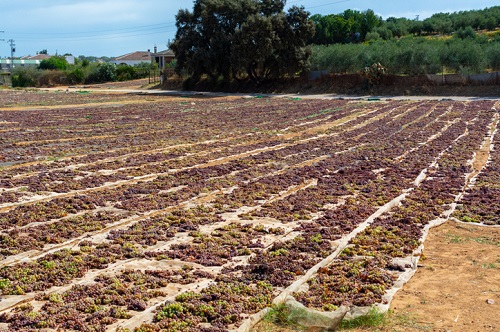Sticky Business of Pedro Ximénez
Last Updated on January 31, 2023.
In the Andalucía region of Spain, just south of Seville, lies a region known as the Sherry Triangle. Here the Winetraveler will find the home of Bull Fighting, Flamenco music and dancing, Formula 1 Grand Prix auto racing, and a grape that’s known for its sticky nature and bears the mysterious name Pedro Ximénez. Commonly referred to as P.X., this grape is usually vinified into intensely sweet and dense wine. And like many ancient varietals, its origins are cloudy. There are several accounts as to where P.X. came from and how it was named, with uncertain authenticity that is circulated as accurate. Still, with a name like Pedro Ximénez, it’s hard not to speculate if there was an actual person named Pedro Ximénez.
RELATED: 9 Authentic Things To Do in Sevilla Spain
The Climate and Terroir of Pedro Ximénez
Nowadays, P.X. is best known for its role in the production of Sherry wines crafted in the three coastal towns of Jerez de la Frontera, Sanlúcar de Barrameda, and El Puerto de Santa María, AKA the Sherry Triangle. Unlike the prolific Palomino grape that’s primarily grown within the triangle, most Pedro Ximénez grapes are grown inland outside the triangle. Here, the soil is white from its richness in calcium carbonate, clay and soft loam composition. While the climate is simultaneously semi-continental and Mediterranean; having long, hot, dry summers, low humidity and short winters, it’s prone to spoilage when grown in Jerez’s damp coastal regions, and Montilla-Moriles’ weather is more ideal for P.X. grapes.
Production of Pedro Ximénez

Pedro Ximénez grapes produce wines in a stunning range of colors, flavors, styles and classifications as follows: Amontillado, Palo Cortado, Oloroso, Crema and Pedro Ximénez. These multiple personalities are achieved in several ways. First, by harvesting late when sugar levels are high or blending with Palomino to create wines with various sugar levels. When harvested late, the grapes are sun-dried in open-air for one to three weeks. After placing the grapes on straw mats, the grapes are spread out by hand and turned over once a day while removing unhealthy bunches, allowing them to dry into raisins.
Free-flowing air is essential, as is low humidity, to avoid the rotting of the grapes. Again, low humidity is precisely why most P.X. grapes are dried in Montilla-Moriles and then brought to Jerez for blending and aging as a single varietal, fortified or “Sherry Blend.”
The Solera System
Any discussion of Sherry is incomplete without mention of the solera system, which is a pyramid-like shaped multi-barrel method of blending and aging wine. Each type of Sherry has its own solera with rows of barrels stacked on top of each other. The bottom barrels contain the oldest wine, and a portion of this is poured off for bottling. The empty space left in the barrel is then filled with wine from the next level of barrels, called the 1st criadera. Then these barrels are topped off with wine from the 2nd criadera, and so on. The barrels of a Solera are never emptied, and the top layer of barrels are replenished from newly produced wine called sobretable. The oldest solera still in use is at OsborneWines in Cádiz and dates back to 1790.
RELATED: The Complete Guide to Sherry Wine
Flavors of Pedro Ximénez
On its own, P.X. is thick and sticky with a dark molasses-like color. Its bouquet is vibrant with predominantly sweet notes of dried raisins, figs, and dates, accompanied by the aromas of honey, jam and candied fruit, while reminiscent of roasted coffee, dark chocolate, licorice and tobacco.
Food Pairing Pedro Ximénez Wines
A few culinary complements to enjoy with Pedro Ximénez are Manchego cheese, Cabrales blue cheese, Gorgonzola cheese, brazil nuts, game terrine, foie gras, spicy curry with coconut milk, pecan pie, gingerbread, ice cream especially vanilla and rum-raisin, dark chocolate, churros, Tiramisu, strawberries, banana, citrus and your favorite coffee beverage.
Current Countries Producing Pedro Ximénez:
Spain
Argentina
Australia
Chile
Similar Varieties
Moscatel de Alejandria
Baladi
Notable Pedro Ximénez Producers:
Marks & Spencer Very Rare, Spain
Gonzalez Byass Noe Muy Viejo, Spain
Gonzalez Byass Nectar Dulce, Spain
Emilio Lustau ‘Solera Reserva’ San Emilio, Spain
Domecq Vina 25, Spain
Bodegas Toro Albala Don PX Seleccion, Spain
Bodegas Toro Albala Don PX Gran Reserva, Spain
Bodegas Toro Albala Don PX Convento Seleccion, Spain
Bodegas Toro Albala Don PX Spain
Alvear Solera 1927, Spain
Alvear de Anada, Spain
Alvear 1927 Spain
A.R. Valdespino El Candado, Spain
Vina Falernia Reserva, Chile
Mayu, Chile
Turkey Flat Vineyards, Australia
Dandelion Vineyards’ Legacy of Australia’ XXXO, Australia
Capitulo 7, Argentina
Learn About These Other Wine Grape Varieties
Written By Jeff Bareilles
Jeff or “JB” is a native to the San Francisco Bay area and wants to live in a world where wine is served with every meal. As a beverage and food professional with more than 20 years of experience, he’s contributed to The Food Lover’s Guide to Wine; The Pho Cookbook (James Beard Award Best Signal Subject 2018); Unforgettable: The Bold Flavors of Paula Wolfert’s Renegade Life (James Beard Award Lifetime Achievement Award 2018); Manresa: An Edible Reflection; Happiness is on the Plate: Episode #1; Wine Spectator; Wine Enthusiast; The Wall Street Journal; San Francisco Chronicle; and GQ Magazine. When he’s not “tasting” and eating he’s writing about food and beverage or developing recipes in his laboratory (AKA: kitchen).